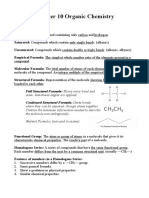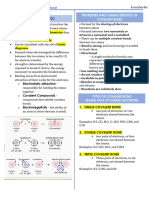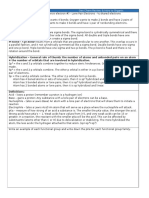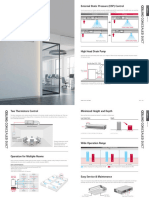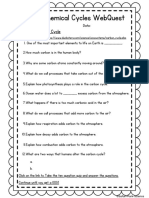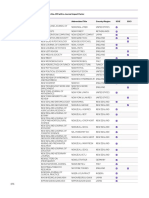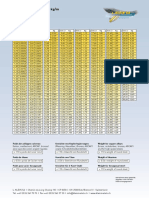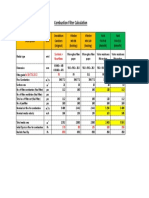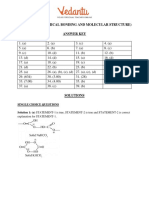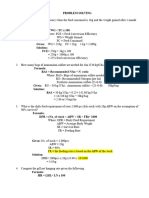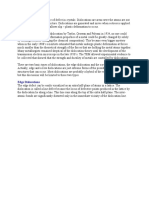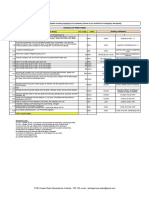OCR (A) Chemistry A-Level
Module 4 - Core Organic Chemistry
Definitions and Concepts
www.pmt.education
� Definitions and Concepts for OCR (A) Chemistry A-level
Module 4 - Core Organic Chemistry
4.1.1 - Basic Concepts of Organic Chemistry
Alicyclic: an aliphatic compound that is arranged in non-aromatic rings (with or without side
chains).
Aliphatic: a compound containing carbon and hydrogen atoms joined in straight or branched
chains or in non-aromatic rings.
Alkane: a homologous series with the general formula CnH2n+2.
Alkyl: a group with the general formula CnH2n+1.
Aromatic: an organic compound containing a benzene ring.
Curly Arrow: shows the movement of a pair of electrons. Curly arrows must start from a
bond, a lone pair of electrons or a negative change.
Dipole: a partial charge on an atom which is caused by the differing electronegativities of
atoms in a covalent bond.
Displayed Formula: the relative positions of atoms and the bonds between them. E.g.
Ethanol:
Empirical Formula: the simplest whole number ratio of atoms of each element present in a
compound.
Functional Group: a group of atoms responsible for the characteristic reactions of a
compound.
General Formula: the simplest algebraic formula of a member of a homologous series. E.g.
Alkane: CnH2n+2.
Heterolytic Fission: when a covalent bond breaks, one bonding atom receives both
electrons from the bonded pair.
www.pmt.education
�Homologous Series: a series of organic compounds containing the same functional group
with successive members differing by -CH2.
Homolytic Fission: when a covalent bond breaks, each bonding atom receives one electron
from the bonding pair, forming 2 radicals.
IUPAC: International Union of Pure and Applied Chemistry.
Molecular Formula: the number and type of atoms of each element in a molecule.
Nomenclature: the naming system for compounds.
Organic Compound: a carbon-containing compound.
Radical: a species with an unpaired electron. E.g. Cl•.
Reaction Mechanism: a series of steps that represent the overall reaction by showing the
breaking and forming of bonds using curly arrows.
Saturated: an organic compound which only contains C-C single bonds.
Skeletal Formula: the simplified organic formula, shown by removing hydrogen atoms from
alkyl chains, leaving the carbon skeleton and the functional groups. E.g. butan-2-ol
Structural Formula: the minimal detail that shows the arrangement of atoms in a molecule.
E.g. butane: CH3(CH2)2CH3.
Structural Isomers: compounds with the same molecular formula but different structural
formulae.
Unsaturated: an organic compound which contains at least one C=C double bond, a C≡C
triple bond or an aromatic ring.
4.1.2 - Alkanes
σ-bond: a type of covalent bond which forms when atomic orbitals overlap head-on. Sigma
(σ) bonds can rotate freely.
Alkane: a homologous series with the general formula CnH2n+2.
www.pmt.education
�Boiling point: the temperature at which a liquid boils and becomes a gas. Shorter, more
branched alkanes have higher boiling points as there are weaker London forces between the
molecules which require less energy to overcome.
Bond Enthalpy: the energy required to break one mole of gaseous bonds. Actual bond
enthalpies may differ from the average as the average bond enthalpy considers a particular
bond in a range of molecules.
Complete Combustion: when a compound is burnt in a plentiful supply of oxygen. When
alkanes are completely combusted, the only products are water and carbon dioxide.
Covalent Bond: a strong bond formed between 2 atoms due to the electrostatic attraction
between a shared pair of electrons and the atomic nuclei.
Electron Pair Repulsion: pairs of electrons around a nucleus repel each other so the shape
that a molecule adopts has these pairs of electrons positioned as far apart as possible. As a
result, carbon atoms in alkanes have a tetrahedral shape and a bond angle of 109.5°.
Homolytic Fission: when a covalent bond breaks, each bonding atom receives one electron
from the bonding pair, forming 2 radicals.
Hydrocarbon: a compound which contains hydrogen and carbon atoms only.
Incomplete Combustion: when a compound is burnt in a limited supply of oxygen. When
alkanes are incompletely combusted, water, carbon monoxide, particulates and some carbon
dioxide may be produced.
Initiation: the first step in a radical substitution mechanism, involving the formation of the
radicals.
London Forces: induced dipole-dipole interactions caused when the random movement of
electrons creates a temporary dipole in one molecule which then induces a dipole in a
neighbouring molecule.
Polar Bond: a covalent bond that has a permanent dipole due to the different
electronegativities of the atoms that make up the bond.
Propagation: the intermediate steps in a radical substitution mechanism where a radical
reacts with another species.
Radical: a species with an unpaired electron, E.g. Cl•.
Radical Substitution: a type of substitution reaction in which a radical replaces another
atom/ group of atoms in a compound. Alkanes can undergo radical substitution reactions with
chlorine or bromine in the presence of UV light, forming a mixture of organic products (further
substitution or reactions at different positions may occur).
www.pmt.education
�Saturated: an organic compound which only contains single C-C bonds.
Termination: the final steps in a radical substitution mechanism in which 2 radicals react
together to form a species which only contains paired electrons.
Tetrahedral: the shape of a molecule in which the central atom has 4 bonding pairs of
electrons.
4.1.3 - Alkenes
σ-bond: a type of covalent bond which forms when atomic orbitals overlap head-on. Sigma
(σ) bonds can rotate freely.
π-bond: a type of covalent bond formed when adjacent p orbitals overlap sideways above
and below the bonding C atoms. Pi (π) bonds can’t be rotated. As π-bonds have low bond
enthalpy, alkenes are more reactive than alkanes.
Addition Polymerisation: the formation of a long chain molecule when many monomers join
together (the polymer is the only product).
Addition Reaction: a reaction in which molecules combine to form a single product.
Alkene: an organic compound containing at least one C=C double bond.
Biodegradable: a substance that can be decomposed by bacteria or other living organisms.
Bond Enthalpy: the energy required to break one mole of gaseous bonds. Actual bond
enthalpies may differ from the average as the average bond enthalpy considers a particular
bond in a range of molecules.
Cahn-Ingold-Prelog (CIP) Priority Rules: a set of rules used to identify whether a
stereoisomer is E or Z. Atoms with a higher atomic number have a higher priority. If the
highest priority substituents on the same side of the double bond (both above or below), it’s
the Z isomer whereas if the highest priority groups are on the opposite sides (one above and
one below), it’s the E isomer.
Catalyst: a substance which increases the rate of a reaction without being used up.
www.pmt.education
�Cis-Trans Isomerism: a type of E/Z isomerism in which the two substituent groups attached
to the cabon atoms are the same. According to the CIP priority rules, cis isomers have the
highest priority substituents on the same side of the double bond (both above or below) while
trans isomers have them on the opposite sides (one above and one below).
Covalent Bond: a strong bond formed between 2 atoms due to the electrostatic attraction
between a shared pair of electrons and the atomic nuclei.
Electron Pair Repulsion: pairs of electrons around a nucleus repel each other so the shape
that a molecule adopts has these pairs of electrons positioned as far apart as possible. As a
result, carbon atoms in alkenes have a trigonal planar shape and a bond angle of 120°.
Electrophile: an electron pair acceptor.
Electrophilic addition: a reaction in which a π bond is broken and 2 new σ bonds form as a
result of the addition of an electron pair acceptor (electrophile).
E/Z Isomerism: a type of stereoisomerism caused by the restricted rotation of π bonds. Two
different groups must be attached to each carbon atom of the C=C group. According to the
CIP priority rules, Z isomers have the highest priority substituents on the same side of the
double bond (both above or below) while E isomers have them on the opposite sides (one
above and one below).
Heterolytic Fission: when a covalent bond breaks, one bonding atom receives both
electrons from the bonding pair, resulting in the formation of oppositely charged ions.
Hydrocarbon: a compound which contains carbon and hydrogen atoms only.
Markownikoff’s Rule: used to predict what the major product of an addition reaction will be
when H-X is added to an unsymmetrical alkene. H attaches to the less substituted carbon to
generate the more stable carbocation intermediate.
Monomer: a small molecule that is used to form polymers.
Photodegradable: a substance that can be broken down by light.
Polymer: a large molecule made from many small units that have been bonded together.
Primary Carbocation: a molecule in which the carbon with the positive charge is only
attached to one alkyl group. This is the least stable carbocation.
Repeat Unit: a structure within a polymer that appears over and over again. Joining many
repeat units together would form the polymer.
Secondary Carbocation: a molecule in which the carbon with the positive charge is
attached to two alkyl groups. This is more stable than a primary carbocation but less stable
than a tertiary carbocation.
www.pmt.education
�Stereoisomers: compounds with the same structural formula but a different arrangement of
atoms in space.
Structural Formula: the minimal detail that shows the arrangement of atoms in a molecule.
E.g. butane: CH3(CH2)2CH3.
Tertiary Carbocation: a molecule in which the carbon with the positive charge is attached to
three alkyl groups. This is the most stable type of carbocation.
Trigonal Planar: the shape of a molecule in which the central atom has 3 bonding pairs of
electrons.
Unsaturated: an organic compound containing at least one C=C double bond, a C≡C triple
bond or an aromatic ring. The presence of a C=C double bond means that bromine water will
be decolourised.
4.2.1 - Alcohols
Alcohol: an organic compound containing the OH functional group. The polarity of the OH
functional group means that alcohols can form hydrogen bonds and are soluble in water
(when the alkyl chain is short). In addition to this, alcohols have a relatively low volatility
compared with alkanes.
Aldehyde: an organic compound containing the -CHO functional group. Aldehydes can be
formed from the oxidation of primary alcohols using Cr2O72-/H+ and
distillation.
Alkene: an organic compound containing a C=C double bond. Alkenes can be formed from
alcohols via the elimination of H2O using an acid catalyst and heat.
Carboxylic Acid: an organic compound containing the -COOH functional group. Carboxylic
acids can be formed from the oxidation of primary alcohols using Cr2O72-/H+ and
reflux.
Combustion: a rapid exothermic reaction of a substance with oxygen.
Elimination: a type of reaction in which 2 atoms/ groups of atoms are removed from a
molecule.
Haloalkanes: an organic compound containing a halogen atom (F/ Cl/ Br/ I) bound to an
alkyl chain. Haloalkanes can be formed from alcohols via a substitution reaction with halide
ions in the presence of acid.
Ketone: an organic compound containing the C=O functional group in the middle of an alkyl
chain. Ketones can be formed by the oxidation of a secondary alcohol.
www.pmt.education
�Oxidation: the loss of electrons/ increase in oxidation number. Alcohols can be oxidised
using Cr2O72-/H+.
Oxidising Agent: a substance that can oxidise another species while being reduced.
Polar Bond: a covalent bond in which there is an unequal share of the electrons between
the 2 atoms due to the differing electronegativities of the atoms involved. One atom will have
a partial positive charge while the other will have a partial negative charge.
Primary Alcohol: an alcohol in which the OH is attached to a primary carbon atom (i.e.
RCH2OH). Primary alcohols can be oxidised to form either an aldehyde or a carboxylic acid,
depending on the conditions.
Secondary Alcohol: an alcohol in which the OH is attached to a secondary carbon atom
(i.e. R2CHOH). Secondary alcohols can be oxidised under reflux with Cr2O72-/H+to form a
ketone.
Tertiary Alcohol: an alcohol in which the OH is attached to a tertiary carbon atom (i.e.
R3COH). Tertiary alcohols cannot be oxidised.
4.2.2 - Haloalkanes
Bond Enthalpy: the energy required to break one mole of gaseous bonds. The bond
enthalpy of the carbon halogen bond in haloalkanes decreases from C-F to C-I.
CFC: a class of compound made up of carbon, fluorine and chlorine, used as refrigerants
and aerosol propellants. CFCs can be broken down by UV light in the upper atmosphere to
form chlorine radicals which catalyse the breakdown of ozone.
Haloalkane: an organic compound containing a halogen atom (F/ Cl/ Br/ I) bound to an alkyl
chain.
Hydrolysis: the breakdown of a compound as a result of a reaction with water. The rate of
haloalkane hydrolysis for different carbon-halogen bonds can be determined via a reaction
with water in the presence of AgNO3and ethanol.
Nucleophile: an electron pair donor.
Nucleophilic Substitution: a reaction in which an electron pair donor attacks an
electrophilic atom (an atom with a partial or full positive charge) to replace an atom / group of
atoms.
Ozone: a molecule with the formula O3, which absorbs UV light in the atmosphere. The
breakdown of ozone can be catalysed by chlorine radicals as well as other radicals such as
•NO.
www.pmt.education
�Radical: a species with an unpaired electron (e.g. •Cl).
Substitution: a reaction in which one atom/ group of atoms replaces another. Haloalkanes
can undergo substitution reactions with aqueous alkali or with water. The rate of reaction
increases from C-F to C-I due to the decreasing bond enthalpy of the carbon-halogen bond.
4.2.3 - Organic Synthesis
Anhydrous Salt: a salt such as MgSO4or CaCl2which is used to remove traces of water
from an organic solution.
Distillation: a technique in which a liquid is heated then the vapour is cooled and collected in
a separate flask to the reaction mixture. During distillation, the condenser must be positioned
horizontally.
Functional Group: a group of atoms responsible for the characteristic reactions of a
compound.
Quickfit Apparatus: glassware that easily fits together in a variety of arrangements.
Redistillation: a technique used to purify an organic liquid using multiple distillations.
Reflux: the continual boiling and condensing of a reaction mixture. This is to ensure that the
reaction goes to completion. During reflux, the condenser must be positioned vertically.
Separating Funnel: a piece of apparatus that is used to purify an organic liquid by removing
the organic layer from an aqueous layer.
Synthetic Route: a series of steps that are followed to make a specific compound.
4.2.4 - Analytical Techniques
Elemental Analysis: a sample is analysed to determine the proportion of elements that
make up the compound present. This is done by converting a known amount of an unknown
sample into simple known compounds.
Fragmentation: during mass spectrometry, unstable molecular ions break down into smaller
fragments.
Fragment Ions: smaller ions formed when an unstable molecular ion breaks down during
mass spectrometry.
www.pmt.education
�Infrared Radiation: a type of electromagnetic radiation that is absorbed by covalent bonds,
causing them to vibrate at a specific frequency.
Infrared Spectroscopy: a technique used to identify particular bonds and functional groups
within a molecule. This technique has been used to link global warming with increased
energy usage as atmospheric gases containing C=O, O-H and C-H bonds (such as CO2, H2O
and CH4) show distinct peaks on IR spectra. IR spectroscopy is used to monitor gases
causing air pollution (CO and NO from car emissions) and to measure alcohol in the breath in
modern breathalysers.
M+1 Peak: a small peak on a mass spectrum caused by the presence of a small proportion
of carbon-13.
M/Z Ratio: the mass to charge ratio on a mass spectrum. This is equivalent to the mass of
an ion.
Mass spectrometry: a technique used to identify compounds and determine relative
molecular mass.
Molecular Ion Peak: the peak on a mass spectrum with the highest m/z value, used to
determine molecular mass of a compound.
Molecular Mass: the total number of atoms of each element in the compound.
www.pmt.education









